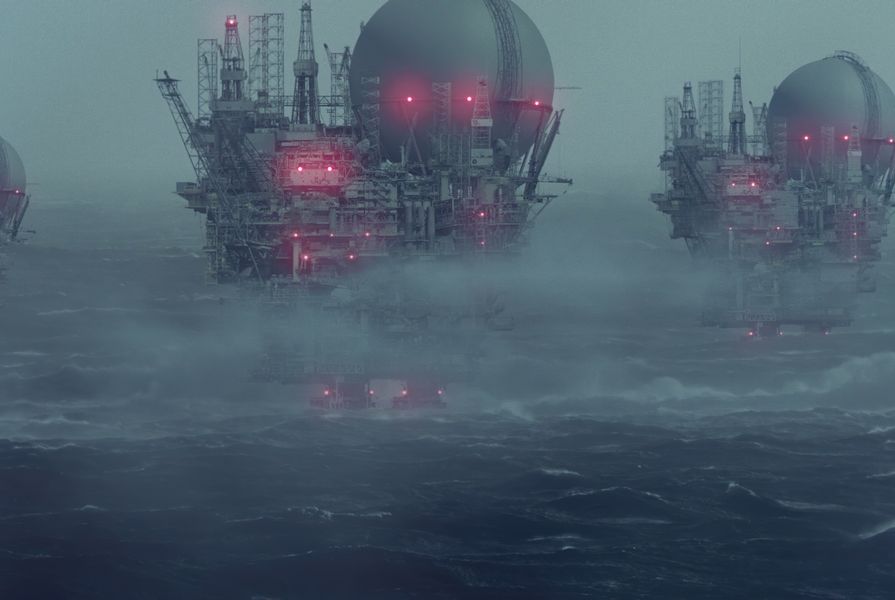“We would be wise to watch these jumpy artists as closely as budgerigars were watched down a coalmine. When they topple from the perch, it may already be too late to run for the lift-shaft. The sky will be transformed into an uncontained cloud of intelligence … the unimaginable imagined … These are the first seismic whispers. Soon it will be everywhere, overheard conversations with no human source. Soon we will all think it. And then it will happen.” —Iain Sinclair1
Planetary Redesign at the National Gallery of Victoria, the first major Australian solo exhibition of filmmaker and speculative designer Liam Young, invites us to imagine the unimaginable, to collectively explore challenging possible futures, and to ask whether they are extreme – or simply pragmatic. The show also reveals that Young may be one of the most intriguing Australian architects around. “Architecture,” he suggests during an enthralling lecture at Melbourne School of Design in July, is “telling stories with and through space.”
The exhibition pivots around two major works: The Great Endeavor, direct from its world-premiere at the 2023 Venice Biennale of Architecture, and the acclaimed Planet City, commissioned for the NGV Triennial 2020. Both films suggest planetary-scale systemic responses to planetary-scale systemic challenges that we may need to reach for, at least in some way. Although vividly detailed, they hover artfully between ambiguity and clarity, between tomorrow and today. African-American writer Samuel Delany remarked that “[There] are very few ‘ideas’ in science fiction. The resonance between an idea and a landscape is what it’s all about.”2 In a sense, Young’s films are sketches of awkward choices rather than blueprints of material structures. Yet the ideas resonate by being made material and stretched over imagined landscapes.
The Great Endeavor (still) offshore carbon removal fans by Liam Young.
Image: Courtesy Liam Young
The Great Endeavor envisions a global system of greenhouse gas extraction and storage machines, strung across oceans in international waters and powered by renewables. It depicts the kind of brute-force un-civil engineering that may be required to extract the vast amounts of carbon we have already put into the atmosphere.
In Planet City, Young explores US biologist E. O. Wilson’s notion of a “Half-Earth,”3 in which half the planet is designated a human-free nature reserve, to preserve biodiversity. Young draws out its corollary, a hyper-dense urbanization in which the world’s population lives on only 0.02 percent of the earth’s surface. (This puts today’s tiresome YIMBY–NIMBY debates into perspective.) Young uses subdued hues to illustrate the city at dusk, its hulking machinery. Drawing the eye, however, are traces of humanity, flashes of culture, as mesmeric slo-mo figures dance around the technologies. Young suggests that the city “smells of soil, hard drives and sweet fruit,” further evoking this interplay of culture, nature and technology. He tells me that the dancers are performing care rituals, noting that “it’s impossible to separate technology and culture. We don’t evolve out of mythology.”
Residential mountains in Planet City (still )by Liam Young.
Image: Courtesy Liam Young
The lovingly detailed, re-embroidered Exxon Mobil and Shell costumes produced for the Planet City film with Ane Crabtree, and exhibited here, are another symbol of this complexity. They recall the argument of another Australian-via-California, Saul Griffith, in his book The Big Switch:4 that we cannot afford to demonize fossil fuel companies, even as we move rapidly away from them. We will need their capital, skills and technologies for this transition, even as we might help them locate their conscience.
By using costumes, scenery, rituals and soundtracks, Young folds a subtlety and ambiguity into what is usually a binary opposition. He is quick to distance his films from “proposals,” firmly rejecting any associations with works such as Danish architect Bjarke Ingels’ Masterplanet or the Neom atro-city planned for Saudi Arabia. He clearly has little time for their hubris, characterizing these projects as unethical and self-serving – a form of continuing colonization. If anything, Young says, his films are intended to “corrupt our ideas about the future” rather than construct them.
The Great Endeavor (still) offshore storage well by Liam Young.
Image: Courtesy Liam Young
Nonetheless, these films pose a complex question: How do we collectively organize ourselves to work at the scale of the climate and biodiversity crisis? The real potency of Young’s films may lie not in the drawings themselves, but in what they imply. Rather than assemblages of matter, perhaps we should read the works as embodiments of the “dark matter” of organization, policy, law, decision-making and coordination required for us to get our shit together at planetary scale. In this, there’s a deep pragmatism to Young’s work. “We don’t talk about carbon removal,” he says. But “it’s the only robust viable solution, if it goes hand-in-hand with ending fossil fuel production.”
Despite all the care taken with realizing a detailed on-screen vision, the key question in his mind is who does this, as much as how. Young opens our eyes to the inconvenient truth that climate action is not about either citizen-led behaviour change or large-scale geoengineering, but must probably be about both. He believes that a singular focus on individual responsibility to bear the work of carbon removal is not only unlikely to work, but reinforces the engineered individualism that produced this mess in the first place. He describes how “the fossil fuel industry has spent decades telling us to focus on our individual decisions whilst they continue to work at global scale.”
The Great Endeavor (still) offshore wind farm by Liam Young.
Image: Courtesy Liam Young
At the same time, acts at community scale can prepare the ground for large-scale systems change, and vice versa. Although Planetary Redesign does not dwell on the detail of small-scale behaviour change, Young recognizes the necessity of these multiple, nested moves. Further, the films are important in allowing us to rehearse a third position that relies on the planetary technologies that require global collaboration, but also on complex forms of folk culture that technocrats cannot imagine.
Perhaps it is no coincidence that the title of The Great Endeavour echoes that of Amitav Ghosh’s The Great Derangement.5 For Ghosh, this “derangement” includes a failure of our art and culture to prepare us for “a substantially altered world,” engaging instead in “modes of concealment that prevented people from recognizing the realities of their plight.” This may be broadly true, but Young, at least, is not holding back from describing these “altered worlds.”
We might level a criticism that the “how” and “who” of global systems-scale collaboration is only implicit in Young’s work. Writers like Kim Stanley Robinson, author of the novel The Ministry for the Future,6 sketch out the possible mechanics of these organizations: How would it work? Who does what? Which disciplines? But equally, Ministry rarely makes the lived experiences of “altered worlds” come alive in a tangible sense. This is where the likes of Young step in, exploring a new kind of architecture, not so much in its literal materiality and tectonics — though he does this too — but through its mode of engagement.
Algae lakes in Planet City (still )by Liam Young.
Image: Courtesy Liam Young
His use of media places Young alongside other visionary urban designers, few of whom are recognized as being in “the industry.” These include the brilliant African-American production designer Hannah Beachler and the Brooklyn-based Nigerian visual artist Olelakan Jeyifous. The latter’s African Conservation Effort/All-Africa Protoport installation at this year’s Venice Biennale presents an alternate history of post-independence Africa, addressing vast renewable energy infrastructures and biodiversity reserves. Beachler, talking about her direction for the world-building that so vividly realized the fictional city of Wakanda in the Black Panther films, said: “It’s about community. It’s about family. It’s about kids. It’s about rituals, spirituality, the things that you don’t see in normal futurescapes.”7 Whilst the world-building of Young, Beachler and Jeyifous can be richly textured, they also draw in the audience to imagine hard and soft infrastructures, matter and dark matter, by foregrounding the culture of these places.
Young’s films – like Beachler’s and Jeyifous’s – are open, generative and provocative acts of cultural invention, “altered worlds” that come alive in that shimmering resonance between landscapes and ideas. All have an adaptive “used universe” sensibility that Young invokes when he recalls William Gibson’s famous line “The street finds its own uses for things” in our interview.
Recalling Sinclair’s quote from 1990, the first mention of climate change in the London Review of Books, Planetary Redesign is indeed “the unimaginable imagined,” asking us to leave the NGV beginning to share “seismic whispers” and synchronise our feelings about what it implies, and what that might mean. It is up to all of us to find our own use for these questions.
Liam Young: Planetary Redesign is on exhibition at the National Gallery of Victoria until 11 February 2024.
- Iain Sinclair, “Bad News,” London Review of Books, vol. 12, no. 23, 6 December 1990; lrb.co.uk/the-paper/v12/n23/iain-sinclair/bad-news.
- Samuel Delany, “Letter to a Critic: Popular Culture, High Art, and the S-F Landscape” in The Jewel-Hinged Jaw: Notes on the Language of Science Fiction (New York: Dragon Press, 1977).
- Edward O. Wilson, Half-Earth: Our Planet’s Fight for Life (New York: Liveright Publishing Corporation, 2016).
- Saul Griffith, The Big Switch: Australia’s Electric Future (Melbourne; Black Inc, 2022).
- Amitav Ghosh, The Great Derangement: Climate Change and the Unthinkable (Chicago: University of Chicago Press, 2016)
- Kim Stanley Robinson, The Ministry for the Future (New York: Orbit Books, 2020).
- Hannah Beachler, Design in a Frame of Emotion (London: Sternberg Press, 2020).































